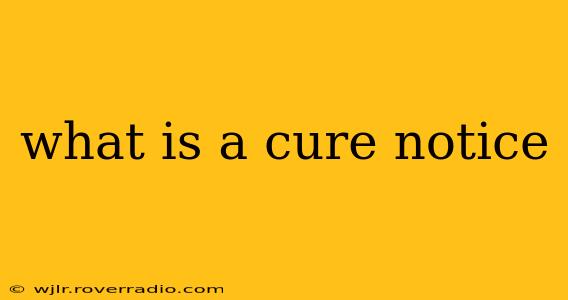A cure notice, often called a "cure letter," is a formal notification sent to a party that has breached a contract, outlining the specific breach and providing a timeframe to rectify the situation. It essentially gives the breaching party a chance to "cure" the default before more severe consequences are enforced. Think of it as a final warning before more drastic actions are taken. This is crucial in various contexts, from commercial contracts to lease agreements and even employment situations, although the specifics may vary.
This post will delve deeper into the specifics of cure notices, exploring what they contain, when they're used, and what happens if the cure isn't successful.
What Does a Cure Notice Typically Include?
A well-written cure notice typically includes the following key elements:
- Identification of the Parties: Clearly stating the names and addresses of both the party issuing the notice (the "non-breaching" party) and the party receiving the notice (the "breaching" party).
- Specific Breach: A detailed description of the contract violation. Vague language is detrimental; the notice must explicitly state what was breached and how. This often includes referencing specific clauses or sections within the original contract.
- Date of Breach: Pinpointing when the breach occurred is vital for establishing a timeline.
- Required Cure: Precisely outlining the actions the breaching party must take to remedy the breach. This should be clear, concise, and actionable. Ambiguity can lead to further disputes.
- Cure Period: Specifying a reasonable timeframe within which the breaching party must complete the required cure. This period should comply with any relevant legal requirements or those stipulated within the contract itself.
- Consequences of Failure to Cure: Clearly stating the repercussions if the breaching party fails to cure the default within the given timeframe. This could involve termination of the contract, legal action, financial penalties, or other remedies.
- Contact Information: Providing contact details for further communication and clarification.
When is a Cure Notice Used?
Cure notices are utilized in various situations where a contractual breach has occurred, and the non-breaching party wants to afford the breaching party an opportunity to rectify the situation before resorting to more drastic measures. Common scenarios include:
- Breach of Contract: Failure to meet obligations specified in a commercial contract, such as delivering goods or services as agreed.
- Lease Agreements: Non-payment of rent, damage to property, or violation of lease terms.
- Employment Contracts: Serious infractions by an employee, though often subject to specific employment laws and procedures.
- Loan Agreements: Missed payments or failure to adhere to loan terms.
What Happens If the Cure is Unsuccessful?
If the breaching party fails to cure the default within the specified timeframe, the non-breaching party is usually entitled to pursue remedies outlined in the contract or under applicable law. These remedies can include:
- Contract Termination: The contract may be terminated, releasing both parties from further obligations.
- Legal Action: The non-breaching party may file a lawsuit to seek damages, specific performance, or other legal remedies.
- Financial Penalties: The contract may stipulate specific financial penalties for non-compliance.
How Long is a Cure Period?
The length of the cure period varies depending on the nature of the breach, the contract terms, and applicable laws. There's no one-size-fits-all answer. A reasonable time is usually considered, which could range from a few days to several weeks or even months, depending on the complexity of the issue.
What are the legal implications of a cure notice?
A cure notice holds significant legal weight. It serves as documented evidence of the breach and the attempt to resolve it amicably. Failing to provide a proper cure notice can impact the non-breaching party's ability to later enforce their rights under the contract. It is often recommended to seek legal counsel to ensure the notice is properly drafted and complies with all applicable legal requirements.
In conclusion, a cure notice is a critical legal instrument providing a formal opportunity to resolve contractual breaches. Understanding its components and implications is essential for both parties involved in any contractual agreement. Remember, this information is for educational purposes only and does not constitute legal advice. It's always wise to consult with a legal professional for guidance specific to your situation.
